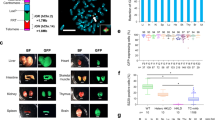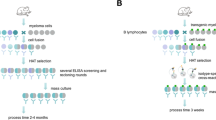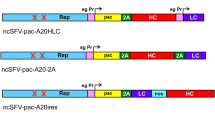Abstract
Human immunoglobulin transgenic mice provide a method of obtaining human monoclonal antibodies (Mabs) using conventional hybridoma technology. We describe a novel strain of human immunoglobulin transgenic mice and the use of this strain to generate multiple high-avidity human sequence IgGκ Mabs directed against a human antigen. The light chain transgene is derived in part from a yeast artificial chromosome clone that includes nearly half of the germline human Vκ region. In addition, the heavy-chain transgene encodes both human μ and human γ1 constant regions, the latter of which is expressed via intratransgene class switching. We have used these animals to isolate human IgGκ Mabs that are specific for the human T-cell marker CD4, have high binding avidities, and are immunosuppressive in vitro. The human Mab-secreting hybridomas display properties similar to those of wild-type mice including stability, growth, and secretion levels. Mabs with four distinct specificities were derived from a single transgenic mouse, consistent with an extensive diversity in the primary repertoire encoded by the transgenes.
This is a preview of subscription content, access via your institution
Access options
Subscribe to this journal
Receive 12 print issues and online access
$209.00 per year
only $17.42 per issue
Buy this article
- Purchase on Springer Link
- Instant access to full article PDF
Prices may be subject to local taxes which are calculated during checkout
Similar content being viewed by others
References
Kohler, G. and Milstein, C. 1975. Continuous cultures of fused cells secreting antibody of predefined specificity. Nature 256: 495–497.
Goldstein, G., Schindler, J., Tsai, H., Cosimi, A.B., Russell, P.S., Norman, D., et al. 1985. A randomized clinical trial of OKT3 monoclonal antibody for acute rejection of cadaveric renal transplants. N. Engl. J. Med. 313: 385–391.
Jaffers, G., Fuller, T.C., Cosimi, A.B., Russell, P.S., Winn, H.J., and Colvin, R.B. 1986. Monoclonal antibody therapy: Anti-idiotypic and non-anti-idiotypic antibodies to OKT3 arising despite intense immunosuppression. Transplantation 41: 572–578.
Ehrlich, P.H., Moustafa, Z.A., Justice, J.C., Harfeldt, K.E., Gadi, I.K., Sciorra, L.J., et al. 1988. Human and primate monoclonal antibodies for in vivo therapy. Clinical Chemistry 34: 1681–1688.
Jones, P.T., Dear, P.H., Foote, J., Neuberger, M.S., and Winter, G. 1986. Replacing the complementarity-determining regions in a human antibody with those from a mouse. Nature 321: 522–525.
Newman, R., Albert, J., Anderson, D., Carner, K., Heard, C., Norton, F., et al. 1992. “Primatization” of recombinant antibodies for immunotherapy of human diseases: a macaque/human chimeric antibody against CD4. Bio/Technology 10: 1455–1460.
Griffiths, A.D., Williams, S.C., Hartley, O., Tomlinson, I.M., Waterhouse, P., Crosby, W.L., et al. 1994. Isolation of high affinity human antibodies directly from large synthetic repertoires. EMBO J. 13: 3245–3260.
Hale, G., Clark, M.R., Marcus, R., Winter, G., Dyer, M.J.S., Phillips, J.M., et al. 1988. Remission induction in non-Hodgkin lymphoma with reshaped human monoclonal antibody Campath-1H. Lancet i: 1394–1399.
LoBuglio, A.F., Wheeler, R.H., Trang, J., Haynes, A., Rogers, K., Harvey, E.B., et al. 1989. Mouse/human chimeric monoclonal antibody in man: Kinetics and immune response. Proc. Natl. Acad. Sci. USA 86: 4220–4224.
Knox, S.J., Levy, R., Hodgkinson, S., Bell, R., Brown, S., Wood, G.S., et al. 1991. Observations on the effect of chimeric anti-CD4 monoclonal antibody in patients with mycosis fungoides. Blood 77: 20–30.
Maloney, D.G., Liles, T.M., Czerwinski, D.K., Waldichuk, C., Rosenberg, J., GrilloLopez, A., et al. 1994. Phase I clinical trial using escalating single-dose infusion of chimeric anti-CD20 monoclonal antibody (IDEC-C2B8) in patients with recurrent B-cell lymphoma. Blood 84: 2457–2466.
Bruggemann, M., Caskey, H.M., Teale, C., Waldmann, H., Williams, G.T., Surani, M.A., et al. 1989. A repertoire of monoclonal antibodies with human heavy chains from transgenic mice. Proc. Natl. Acad. Sci. USA 86: 6709–6713.
Bruggemann, M., Spicer, C., Buluwela, L., Rosewell, I., Barton, S., Surani, M.A., et al. 1991. Human antibody production in transgenic mice: expression from 100 kb of the human IgH locus. Eur. J. Immunol. 21: 1323–1326.
Green, L.L., Hardy, M.C., Maynard-Currie, C.E., Tsuda, H., Louie, D.M., Mendez, M.J., et al. 1994. Antigen-specific human monoclonal antibodies from mice engineered with human Ig heavy and light chain YACs. Nature Genetics 7: 13–21.
Taylor, L.D., Carmack, C.E., Schramm, S.R., Mashayekh, R., Higgins, K.M., Kuo, C.-C., et al. 1992. A transgenic mouse that expresses a diversity of human sequence heavy and light chain immunoglobulins. Nucleic Acids Res. 20: 6287–6295.
Davies, N.P., Rosewell, I.R., Richardson, J.C., Cook, G.P., Neuberger, M.S., Brownstein, B.H., et al. 1993. Creation of mice expressing human antibody light chains by introduction of a yeast artificial chromosome containing the core region of the human immunoglobulin κ locus. Bio/Technology 11: 911–914.
Lonberg, N., Taylor, L.D., Harding, F.A., Trounstine, M., Higgins, K.M., Schramm, S.R., et al. 1994. Antigen-specific human antibodies from mice comprising four distinct genetic modifications. Nature 368: 856–859.
Choi, T., Hollenbach, P.W., Pearson, B.E., Ueada, R.M., Weddell, G.N., Kurahara, C.G., et al. 1993. Transgenic mice containing a human heavy chain immunoglobulin gene fragment cloned in a yeast artificial chromosome. Nature Genetics 4: 117–123.
Taylor, L.D., Carmack, C.E., Huszar, D., Higgins, K.M., Mashayekh, R., Sequar, G., et al. 1994. Human immunoglobulin transgenes undergo rearrangement, somatic mutation and class switching in mice that lack endogenous IgM. Internatl. Immunol. 6: 579–591.
Wagner, S.D., Williams, G.T., Larson, T., Neuberger, M.S., Kitamura, D., Rajewsky, K., et al. 1994. Antibodies generated from human miniloci in transgenic mice. Nucleic Acids Res. 22: 1389–1393.
Wagner, S.D., Popov, A.V., Davies, S.L., Xian, J., Neuberger, M.S., and Bruggemann, M. 1994. The diversity of antigen-specific monoclonal antibodies from transgenic mice bearing human immunoglobulin gene miniloci. Eur. J. Immunol. 24: 2672–2681.
Lonberg, N. and Huszar, D. 1995. Human antibodies from transgenic mice. Intern. Rev. Immunol. 13: 65–93.
Collins, T.L., Hahn, W.C., Bierer, B.E., and Burakoff, S.J. 1993. CD4, CD8 and CD2 in T cell adhesion and signalling. Curr. Top. Microbiol. Immunol. 184: 223–233.
Miceli, M.C. and Parnes, J.R. 1993. Role of CD4 and CD8 in T cell activation and differentiation. Adv. Immunol. 53: 59–122.
Doyle, C. and Strominger, J.L. 1987. Interaction between CD4 and class II MHC molecules mediates cell adhesion. Nature 330: 256–258.
Saito, T., Weiss, A., Miller, J., Norcross, M.A., and Germain, R.N. 1987. Specific antigen-la activation of transfected human T cells expressing murine Ti αβ-human T3 receptor complexes. Nature 325: 125–127.
Wofsy, D. and Seaman, W.E. 1985. Successful treatment of autoimmunity in NZB/NZW F1 mice with monoclonal antibody to L3T4. J. Exp. Med. 161: 378–391.
Wofsy, D. and Seaman, W.E. 1987. Reversal of advanced murine lupus in NZB/NZW F1 mice by treatment with monoclonal antibody to L3T4. J. Immunol. 138: 3247–3253.
Waldor, M.K., Sriram, S., Hardy, R., Herzenberg, L.A., Herzenberg, L.A., Lanier, L., et al. 1985. Reversal of experimental allergic encephalomyelitis with monoclonal antibody to a T-cell subset marker. Science 227: 415–417.
Goldberg, D., Morel, P., Chatenoud, L., Boitard, C., Menkes, C.J., Bertoye, P.-H., et al. 1991. Immunological effects of high dose administration of anti-CD4 antibody in rheumatoid arthrits patients. J. Autoimmunity 4: 617–630.
Herzog, C., Walker, C., Pichler, W., Aeschlimann, A., Wassmer, P., Stockinger, H., et al. 1987. Monoclonal anti-CD4 in arthritis. Lancet ii: 1461–1462.
Horneff, G., Burmester, G.R., Emmrich, F., and Kalden, J.R. 1991. Treatment of rheumatoid arthritis with an anti-CD4 monoclonal antibody. Arthritis Rheum. 34: 129–140.
Reiter, C., Kakavand, B., Rieber, E.P., Schattenkirchner, M., Riethmuller, G., and Kruger, K. 1991. Treatment of rheumatoid arthritis with monoclonal CD4 antibody M-T151: Clinical results and immunopharmacologic effects in an open study, including repeated administration. Arthritis Rheum. 34: 525–536.
Wendling, D., Wijdenes, J., Racadot, E., and Morel-Fourrier, B. 1991. Therapeutic use of monoclonal anti-CD4 antibody in rheumatoid arthritis. J. Rheum. 18: 325–327.
Van der Lubbe, P.A., Dijkmans, B.A.C., Markusse, H.M., Nassander, U., and Breedveld, F.C. 1995. A randomized, double-blind, placebo-controlled study of CD4 monoclonal antibody therapy in early rheumatoid arthritis. Arthritis Rheum. 38: 1097–1106.
Van der Lubbe, P.A., Reiter, C., Breedveld, F.C., Kruger, K., Schattenkirchner, M., Sanders, M.E., et al. 1993. Chimeric CD4 monoclonal antibody cM-T412 as a therapeutic approach to rheumatoid arthritis. Arthritis Rheum. 36: 1375–1379.
Moreland, L.W., Bucy, R.P., Tilden, A., Pratt, P.W., LoBuglio, A.F., Khazaeli, M., et al. 1993. Use of a chimeric monoclonal anti-CD4 antibody in patients with refractory rheumatoid arthritis. Arthritis Rheum. 36: 307–318.
Chen, J., Trounstine, M., Alt, F.W., Young, F., Kurahara, C., Loring, J.F., et al. 1993. Immunoglobulin gene rearrangement in B cell deficient mice generated by targeted deletion of the Jh locus. Internatl. Immunol. 5: 647–656.
Chen, J., Trounstine, M., Kurahara, C., Young, F., Kuo, C.-C., Xu, Y., et al. 1993. B cell development in mice that lack one or both immunoglobulin κ light chain genes. EMBO J. 12: 821–830.
Lautner-Rieske, A., Huber, C., Meindl, A., Pargent, W., Schable, K.F., Thiebe, R., et al. 1992. The human immunoglobulin κ locus. Characterization of the duplicated A regions. Eur. J. Immunol. 22: 1023–1029.
Huber, C., Huber, E., Lautner-Reiske, A., Schable, K.F., and Zachau, H.G. 1993. The human immunoglobulin κ locus. Characterization of the partially duplicated L regions. Eur. J. Immunol. 23: 2860–2867.
Karlson, R., Michaelsson, A., and Mattsson, L. 1991. Kinetic analysis of monoclonal antibody-antigen interactions with a new biosensor based analytical system. J. Immunol. Meth. 145: 229–240.
Engleman, E.G., Benike, C., Glickman, E., and Evans, R.L. 1981. Antibodies to membrane structures that distinguish suppressor/cytotoxic and helper T lymphocyte subpopulations block the mixed leukocyte reaction in man. J. Exp. Med. 153: 193–198.
Merkenschlager, M., Buck, D., Beverley, P.C.L., and Sattentau, Q.J. 1990. Functional epitope analysis of the human CD4 molecule: The MHC Class II-dependent activation of resting T cells is inhibited by monoclonal antibodies to CD4 regardless whether or not they recognize epitopes involved in the binding of MHC Class II or HIV gp120. J. Immunol. 145: 2839–2845.
Pargent, W., Meindl, A., Thiebe, R., Mitzel, S., and Zachau, H.G. 1991. The human κ locus. Characterization of the duplicated O regions. Eur. J. Immunol. 21: 1821–1827.
Weichhold, G.M., Ohnheiser, R., and Zachau, H.G. 1993. The human immunoglobulin κ locus consists of two copies that are organized in opposite polarity. Genomics 16: 503–511.
Rath, S., Nisonoff, A., Selsing, E., and Durdick, J.M. 1991. B cell abnormalities induced by a μ Ig transgene extend to L chain isotype usage. J. Immunol. 146: 2841–2847.
Stall, A.M., Kroese, F.G.M., Gadus, F.T., Sieckmann, D.G., Herzenberg, L.A., and Herzenberg, L.A. 1988. Rearrangement and expression of endogenous immunoglobulin genes occur in many murine B cells expressing transgenic membrane IgM. Proc. Natl. Acad. Sci. USA 85: 3546–3550.
Morel, P., Nicolas, J.F., Wijdenes, J., and Revillard, J.P. 1992. Down-regulation of lymphocyte CD4 antigen expression by administration of anti-CD4 monoclonal antibody. Clin. Immunol. Immunopath. 64: 248–253.
Dalesandro, M.R., Pak, K.-Y., Tam, S., Wilson, E., Looney, J.E., Riethmuller, G., et al. 1993. Effects of isotype and Fc region on in vitro function of a mouse/ human chimeric CD4 antibody. Internatl. Immunol. 5: 283–291.
Larin, Z., Monaco, A.P., and Lehrach, H. 1991. Yeast artificial chromosome libraries containing large inserts from mouse and human DNA. Proc. Natl. Acad. Sci. USA 88: 4123–4127.
Marks, J., Tristem, M., Karpas, A., and Winter, G. 1991. Oligonucleotide primers for polymerase chain reaction amplification of human immunoglobulin variable genes and design of family-specific oligonucleotide probes. Eur. J. Immunol. 21: 985–991.
Boyum, A. 1968. Isolation of mononuclear cells and granulocytes from human blood. Scand. J. Clin. Lab. Invest. 21 (suppl.97) 51–76.
Fishwild, D.M. and Saria, E.A. 1991. Investigation and prevention of artifactual staining in flow cytometric analyses of whole blood samples from patients treated with H65-RTA, an anti-CD5 monoclonal antibody conjugated to ricin A chain. J. Immunol. Meth. 144: 27–34.
Author information
Authors and Affiliations
Rights and permissions
About this article
Cite this article
Fishwild, D., O'Donnell, S., Bengoechea, T. et al. High-avidity human IgGκ monoclonal antibodies from a novel strain of minilocus transgenic mice. Nat Biotechnol 14, 845–851 (1996). https://doi.org/10.1038/nbt0796-845
Received:
Accepted:
Issue Date:
DOI: https://doi.org/10.1038/nbt0796-845
This article is cited by
-
Isolation of full-length IgG antibodies from combinatorial libraries expressed in the cytoplasm of Escherichia coli
Nature Communications (2023)
-
Efficacy and mechanism of the anti-CD38 monoclonal antibody Daratumumab against primary effusion lymphoma
Cancer Immunology, Immunotherapy (2022)
-
Streamlined human antibody generation and optimization by exploiting designed immunoglobulin loci in a B cell line
Cellular & Molecular Immunology (2021)
-
Cooperative targeting of melanoma heterogeneity with an AXL antibody-drug conjugate and BRAF/MEK inhibitors
Nature Medicine (2018)
-
Generation and analysis of the improved human HAL9/10 antibody phage display libraries
BMC Biotechnology (2015)



